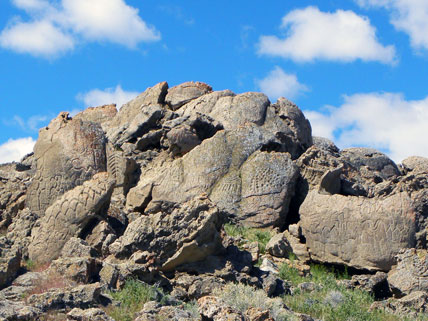
These ancient carvings were found on the shoreline of a now dried-up lake in Nevada.
Evidence of ancient peoples takes many forms—from cave paintings and tools to trash heaps and human remains. Among the most durable artifacts are petroglyphs, which are carvings or drawings on rock. North America is littered with petroglyphs made by various peoples over thousands of years.
Now the time line of the continent’s human prehistory has been pushed back by a discovery in the northern Nevada desert. Archaeologists recently dated a collection of petroglyphs found there to at least 10,000 years old, and perhaps as old as 14,800 years. That makes them possibly 7,000+ years older than the previous record-holding glyphs. The carvings were found on limestone boulders in the bed of Winnemucca Lake, which dried up in the 1930s. Depicted on the boulders are abstract geometric designs, including diamond patterns, swirls, and straight lines. The designs contrast with more figurative images, such as of weapons or prey animals, which give some hint to their meaning. Yet the petroglyphs’ designs must have held meaning for their creators, considering the effort needed to carve them with primitive tools into the hard stone.
Who made these petroglyphs? Although they were found on the Pyramid Lake Paiute Tribe’s reservation land, identifying the early occupants with the Paiute tribe is impossible. The peopling of North America is far too long and complex a history to make such a connection. What is certain is that the lake bed where the petroglyphs were found has had a complicated geological history. About 15,000 years ago, the level of what would later be called Winnemucca Lake began to drop. About 1,800 years later, the lake level rose and then rose and dropped periodically. The rocks on which the glyphs were carved were above the waterline, and thus accessible to the carvers, during at least two different periods.
The Nevada petroglyphs also support the theory that people were already living in the Americas when Ice Age migrants crossed the Bering land bridge. For more on this topic, see “New Findings on the Peopling of the Americas.”
Image credit: © AP Photo/Nevada State Museum, Eugene Hattori
Related Links
- Oldest Petroglyphs on Continent Found in Nevada
This article, which provides the basic information, begins with a dramatic photo of one of the main glyphs.
(Source: San Francisco Chronicle, August 14, 2013) - Dating North America’s Oldest Petroglyphs, Winnemucca Lake Subbasin, Nevada
Read the abstract and view the images of the original report. (The entire article is available for purchase.)
(Source: Journal of Archaeological Science, December 2013) - Winnemucca Lake
Learn how the geography of the area in which the petroglyphs were found allowed human settlement only during certain eras.
(Source: Wikipedia; accessed August 31, 2013) - New Evidence Suggests Stone Age Hunters from Europe Discovered America
Review the evidence suggesting that the Bering land bridge migrants were not the first arrivals in the Americas.
(Source: The Independent, February 28, 2012)




How did the people make petroglyphs and what tools and how long did it take them.?
THANK YOU finally i found a current event that relates to our chapter. <3
Ahhh I need a current event!!!!
I know
What are petroglyphs?!
What is the lake like today?
Thank you for giving me the information of this topic ROFL
it is a really good story but it could be alittle more fun cause it was boring
education is boring in general we can’t change that 🙁